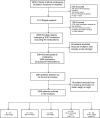Peri-intubation complications in critically ill obese patients: a secondary analysis of the international INTUBE cohort
- PMID: 40361245
- PMCID: PMC12076862
- DOI: 10.1186/s13054-025-05419-2
Peri-intubation complications in critically ill obese patients: a secondary analysis of the international INTUBE cohort
Erratum in
-
Correction: Peri‑intubation complications in critically ill obese patients: a secondary analysis of the international INTUBE cohort.Crit Care. 2025 Jul 31;29(1):338. doi: 10.1186/s13054-025-05475-8. Crit Care. 2025. PMID: 40745665 Free PMC article. No abstract available.
Abstract
Background: Airway management in critically ill obese patients is potentially associated with a higher risk of adverse events due to a constellation of physiological and anatomical challenges. Data from international prospective studies on peri-intubation adverse events in obese critically ill patients are lacking.
Methods: INTUBE (International Observational Study to Understand the Impact and Best Practices of Airway Management In Critically Ill Patients) was an international multicentre prospective cohort study enrolling critically ill adult patients undergoing in-hospital tracheal intubation in 197 sites from 29 countries worldwide from October 1, 2018, to July 31, 2019. This secondary analysis compares airway management practices and outcomes between obese (body mass index-BMI 30 kg/m2) and non-obese patients (BMI 30 kg/m2).
Results: A total of 2946 patients met inclusion criteria for this secondary analysis, 639 (21.7%) obese and 2307 (78.3%) non-obese. Severe peri-intubation hypoxemia was more frequently reported in obese compared to non-obese patients (12.1% vs 8.6% respectively, p = 0.01). Variables independently associated with a higher risk of peri-intubation hypoxemia were baseline SpO2/FiO2 (OR 0.996, 95% CI 0.994-0.997), 30-45° head-up position (OR 1.53, 95% CI 1.04-2.26) and first-pass intubation failure (OR for first-pass success 0.21, 95% CI 0.15-0.29). Obesity (OR 0.71, 95% CI 0.56-0.91) and 20° head-up position (OR 0.67, 95% CI 0.47-0.95) were independently associated with higher likelihood of first-pass intubation failure. In contrast, intubation by staff physician/consultant (OR 1.70, 95% CI 1.30-2.21) or anesthesiologists (OR 1.98, 95% CI 1.55-2.53) were associated with higher first-pass success.
Conclusions: Compared to non-obese patients, obese critically ill exhibit a higher incidence of peri-intubation severe hypoxemia. In this population, worse baseline oxygenation and first-pass intubation failure significantly increase the risk of peri-intubation severe hypoxemia. As obesity is linked to a higher likelihood of first-pass intubation failure, likely driven by more challenging airway features, in this high-risk population first attempt should be performed by an expert operator to minimize peri-intubation complications.
Trial registration: Clinicaltrials.gov NCT03616054 . Registered 3 August 2018.
Keywords: Airway management; Critical care; Intubation; Obesity.
© 2025. The Author(s).
Conflict of interest statement
Declarations. Ethics approval and consent to participate: The study was approved by the Ethics Committee of the coordinating center (Comitato Etico Brianza, No 1420 of July 31, 2018) and then by each local ethics committee according to local regulations, with either the patient’s written consent or waiver of consent for participation. Consent for publication: Not applicable. Competing interests: The authors declare no competing interests.
Figures
Comment in
-
Confused with confounders? Understanding the role of directed acyclic graphs in observational research.Crit Care. 2025 Jul 15;29(1):307. doi: 10.1186/s13054-025-05562-w. Crit Care. 2025. PMID: 40665381 Free PMC article. No abstract available.
References
-
- World Health Organization. Obesity and overweight. https://www.who.int/news-room/fact-sheets/detail/obesity-and-overweight. Accessed 10 Jan 2025.
-
- Lingvay I, Cohen RV, Roux CWL, Sumithran P. Obesity in adults. Lancet. 2024;404:972–87. - PubMed
-
- Schetz M, De Jong A, Deane AM, Druml W, Hemelaar P, Pelosi P, et al. Obesity in the critically ill: a narrative review. Intensive Care Med. 2019;45:757–69. - PubMed
-
- Petrini F, Di Giacinto I, Cataldo R, Esposito C, Pavoni V, Donato P, et al. Perioperative and periprocedural airway management and respiratory safety for the obese patient: 2016 SIAARTI Consensus. Minerva Anestesiol. 2016;82:1314–35. - PubMed
Publication types
MeSH terms
Associated data
LinkOut - more resources
Full Text Sources
Medical
Research Materials
Miscellaneous



